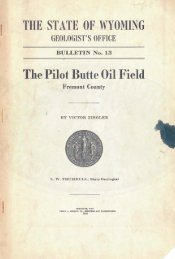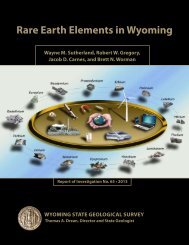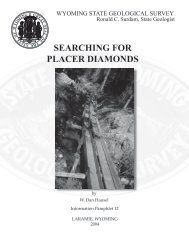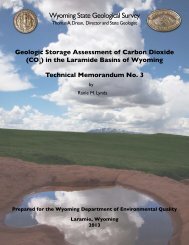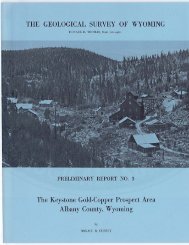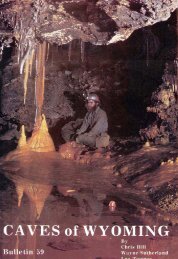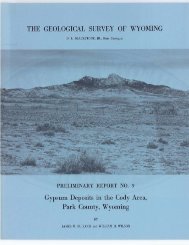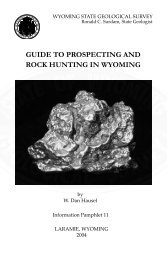The Dinosaurs of Wyoming - Wyoming State Geological Survey ...
The Dinosaurs of Wyoming - Wyoming State Geological Survey ...
The Dinosaurs of Wyoming - Wyoming State Geological Survey ...
You also want an ePaper? Increase the reach of your titles
YUMPU automatically turns print PDFs into web optimized ePapers that Google loves.
CHAPTER XIX<br />
Animals Which Lived with the <strong>Dinosaurs</strong><br />
In relating the association <strong>of</strong> Mesozoic animals with the<br />
dinosaurs we shall speak more fully about the back-boned<br />
animals. <strong>The</strong> lower groups <strong>of</strong> animals, called invertebrates,<br />
were present in abundance in fresh waters and in the seas.<br />
<strong>The</strong> only possible relation between invertebrates and dinosaurs<br />
is that the former may have furnished the reptiles with<br />
food, although the majority <strong>of</strong> known dinosaurs were plant<br />
feeders, living on s<strong>of</strong>t verdure along the lakes, marshes and<br />
rivers, or on higher land, cropping leaves and twigs <strong>of</strong> such<br />
trees and bushes as still exist, for, by the close <strong>of</strong> the Age <strong>of</strong><br />
Reptiles, flowering plants, woody trees, grasses and other<br />
plants had assumed a modern aspect. <strong>The</strong> poplar, willow,<br />
oak and maple were trees then as now.<br />
<strong>The</strong> fishes were abundant throughout the Mesozoic, but<br />
were mostly marine. Only three kinds <strong>of</strong> lung-fishes (dipnoans),<br />
at present found in Africa, have been made known<br />
from the Dinosaur beds. "0.'e do not know that the fishes<br />
were important to the dinosaurian reptiles.<br />
Mesozoic amphibians are few, and scantily known. Some<br />
years ago I reviewed our knowledge <strong>of</strong> the frogs and salamanders<br />
<strong>of</strong> the Age <strong>of</strong> <strong>Dinosaurs</strong>-but they hardly differ from<br />
the frogs and mud-puppies which we see today. -<br />
Birds are known from American dinosaur beds only by<br />
fragments. I am showing here (Figure 46) a Mesozoic bird,<br />
combining many characters. Marine birds, large wingless,<br />
toothed, aquatic, fish-eating types and small, winged, toothed,<br />
possibly fish-eating birds, about the size <strong>of</strong> a pigeon, are<br />
known from the Kansas chalk.<br />
<strong>The</strong> distinguishing character <strong>of</strong> all birds, ancient and modern,<br />
is the possession <strong>of</strong> feathers. No other animal has them.<br />
Birds may have arisen from reptiles, but those reptiles are<br />
yet unknown, nor do we know the stages in the derivation <strong>of</strong><br />
feathers from scales. Bird fossils are among the rarest gems<br />
<strong>of</strong> paleontology, but vve know a few complete fossil birds, some<br />
fossil feathers and a few fossil eggs.<br />
Before the close <strong>of</strong> the mesozoic turtles had diversified<br />
into land-living, marine, and river or swamp turtles.<br />
110




